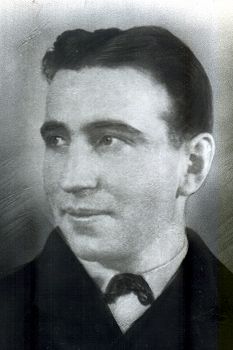“I think we all did a wonderful job, helped by technical things such as computers. We all together were able to make it possible to create a memorial for the heroes of the Lancaster ND 956 AS-I. “Without your help I should not have been able to make a memorial half as good as we have now. When they asked me to help with information about this memorial the “youngsters” did not know I had much material and information about this tragic crash. “But not as much as I wished. I knew that I only had three photos of the crew members. I thought I can ask the R.A.F. for more information but that was a little too easy. I was searching on the Internet and even there I couldn’t find information and photos of “our” Lancaster. “With your kind help and drive we succeeded and can be proud of that. On the 4th of May 2013 the people of Goudriaan and the world will get a stylish and informative memorial. I thank you all, you have worked so hard.” At first it was thought that three crew members were killed. For that reason there were only three crosses during the commemoration in 1946. Text on the new memorial says, “On Sunday the 21st of May 1944, around 22.30 o’clock, 708 bombers take off from several airbases in Southern England for different raids on Nazi-Germany. As ever their mission is to bomb strategic targets. On this particular night these are Duisburg, Hannover and a Belgian airport. So-called “Intruders” fly with the bombers for protection and to bomb airfields with German fighters, intending to keep these out of the sky. “Our” bomber, a four engine AVRO Lancaster MK III, with a wingspan of 34 meters, is part of the 166th squadron of the R.A.F., which is stationed on airfield Kirmington, about 28 kilometres northwest of Grimsby. The crew consists of a pilot, a bomb aimer, three gunners, of whom one is also wireless operator, one navigator and a mechanic. Seven young men who fulfil their mission each with their own different motives and ideals. Each with his own pleasures, fears and beliefs. The Lancaster reaches its target the town of Duisburg, marked earlier by torches and marker flairs. They drop their bombs and hit the southern part of the city. 124 people are killed on the ground, 350 buildings are destroyed and 665 are seriously damaged. When the mission is fulfilled the plane curves back to the west, back to base, back to England. But there is no time for relaxation. The Lancaster is still flying above enemy territory. Not only do the anti-aircraft guns (flak) pose a serious threat, but the Germans also have very effective combat fighters. In contrast with the American bombers, the so-called “Flying Fortresses”, the Lancasters do not have a turret with machine guns on the bottom of the plane. If a German Messerschmitt BF-110 manages to reach a spot below the Lancaster unseen, the situation is very dangerous. The bombers fly on an altitude of approximately 6000 metres when an enemy Messerschmitt manages to intrude into the formation unseen. When it flies about 50 metres below the Lancaster it shoots, with the machine gun, a salvo at an upwards angle. It is a direct hit; heavily burning the plane crashes. It comes down in the polder Zuidzijde, behind the house of the then Mayor R.D.C.M. van Slijpe, 134 Zuidzijde Goudriaan. At about 2.00 o’clock that night inhabitants hear heavy machine gun fire and see the burning plane coming down close to the houses. Due to the tremendous heat coming off the wreck it is impossible to come closer to it than about 150 metres. After a short time soldiers of the German Feldgendarmerie arrive to fence off the terrain. A worker of the municipality Teus den Dikken is assigned, later that day, to search for the human remains. On the same day, at about 19.00 o’clock, the victims are buried in a provisional grave on the graveyard in Goudriaan. In addition to this Lancaster the R.A.F. lost another 30 bombers and fighters that night. Ten crashed in the Netherlands. Planes that brought hope for liberation, manned by young men, who again and again put their lives at stake under enormous pressure. One hit of the artillery or a grenade from an unobserved fighter would mean a certain death . But they went, … so we should be free.” |
